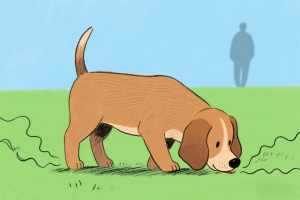The person who knows a dog best is, of course, its owner.As a dog owner, you’re familiar with everything from their favorite toys to their preferred treats. You even know the little signals they give before going to the bathroom. But there are still many things about dogs that remain a mystery. Do they like sweets? Do they sweat? When are they considered fully grown? Countless little secrets are waiting to be discovered. As a proud dog parent, have you ever wondered about these things?Today, let’s take a look at some fun facts about dogs. How many of these did you already know?
-
Unique Nose Print
Every dog has its own unique nose print, much like human fingerprints. These nose prints are one-of-a-kind and remain unchanged throughout a dog’s life. This makes them an important feature for identifying dogs. There has already been significant research into dog nose prints, and just imagine—one day, by simply scanning a dog’s nose with your phone, you could generate a unique dog ID. It would be so much more convenient than traditional ID tags or microchips!
-
Super Sensitive Hearing
While dog owners are well aware of their dog’s incredible sense of smell, their hearing is equally impressive. Dogs have 18 muscles in their ears, giving them exceptional hearing that is about 16 times more sensitive than humans. For instance, while humans typically can’t hear low-frequency sounds from more than 6 meters away, dogs can detect these sounds from up to 24 meters. Dogs also have a broader hearing range, with humans hearing up to 20,000 Hz, while dogs can hear up to 40,000 Hz—or even higher! This heightened hearing ability makes dogs excellent guard animals. Therefore, ears are extremely important for dogs—avoid tugging on their ears for training and make sure to regularly clean them to prevent bacteria from affecting their hearing.
-
Poor Sense of Taste
In comparison to their remarkable sense of hearing and smell, a dog’s sense of taste is fairly poor. While humans and some omnivores have about 10,000 taste buds, dogs have only around 1,700. This means dogs don’t savor food the way humans do; they are more focused on the scent and texture of their food. As a dog owner, be sure to consider how the food smells and feels when preparing meals for your furry friend.

-
Special Sweat Glands
Dogs have two types of sweat glands. The first, called sebaceous glands, are found all over their body and secrete oils. The second type, called apocrine sweat glands, are located in their paw pads and release moisture to help regulate body temperature. However, dogs’ sweat glands aren’t very developed, so their cooling system isn’t as efficient as humans’. Most of the time, dogs rely on heavy panting to cool off. So, during hot summer months, it’s important to prevent your dog from overheating. Avoid putting shoes on your dog that might restrict heat dissipation and always provide plenty of fresh, cool water.
-
How to Calculate a Dog’s Age
Dogs age differently than humans. At one month old, a dog is roughly equivalent to a 1.5-year-old human. By two months, they’re like a 3-year-old human. When a dog reaches one year, it’s roughly like a human turning 18. Most dogs enter middle age around 5 years old, which corresponds to about 40 years in human age. By the time they’re 10, dogs enter their senior years, which is roughly equivalent to being between 60 and 65 years old in human terms.
Dog Lifespan: What Affects It and How to Extend It.Dog lifespans vary depending on factors like breed, body type, and overall health. On average, a dog’s life expectancy is around 15 years, as long as they don’t suffer from any major illnesses. A dog’s lifespan is influenced by its breed, physical condition, and the owner’s care routine. To help your dog live a long and healthy life, it’s essential to follow proper feeding practices that ensure a balanced diet, provide regular vaccinations, and schedule timely health checkups.





